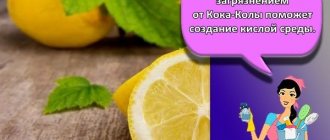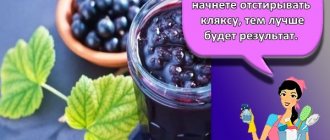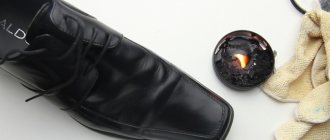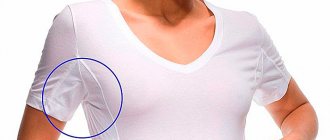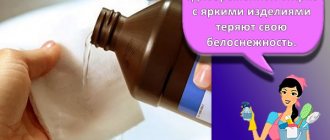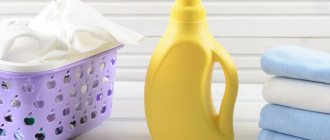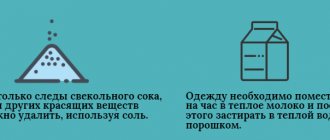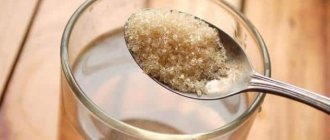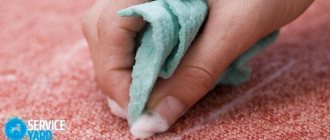08/18/201601/11/2019 Maria Ivanova
White fabrics are more susceptible to the influence of the environment, constant washing and possible contamination than dark ones.
Each of these factors gradually makes things gray or yellow instead of white. To prevent this unpleasant problem from affecting your things, you need to know how to wash white things so that they sparkle again with crystal cleanliness.
Bleach - real or not
You can remove stubborn stains by pre-soaking.
To do this, you need to use bleach, but their choice today is so large that it’s easy to get confused. Even powders already contain this product. The catch is that the result is only the appearance of purity. Manufacturers achieve this effect using luminescent dyes. By attaching to the fibers, they “catch” ultraviolet rays, creating the illusion of whiteness. You should not constantly use such powders - they have a negative effect on the fabric. It is better if the powder contains active oxygen. He is really able to “push out” dirt. However, there is a trick. For oxygen to work, the water temperature must exceed 60 °C. If the fabric is delicate (silk, lace, wool sweater), then the water should not be warmer than 40 °C. A special activator will help to cope with the problem.
- Traditional “Whiteness” remains indispensable when washing white clothes. The product is aggressive, but the result is noticeable immediately, and the price is budget-friendly. But too frequent use of this inexpensive substance can significantly shorten the life of any, even the most durable fabrics. To remove even old stains, you need to pre-soak in an aqueous solution of “Belizna”. Just don’t keep it for too long, or the linen may get damaged. When washing the machine, first pour a little bleach directly into the drum.
- Domestos is used not only for cleaning toilets, but also as a stain remover, as stated on the label. The recommended dosage and soaking time should be followed to ensure satisfactory results.
- Dishwashing liquid. White T-shirts and socks absorb sweat, fats, and dust when worn. As a result, the fabric loses its previous color and becomes yellow. To avoid this, some enterprising housewives use dish gel. After all, its direct purpose is to fight fat. It should be used as a regular powder. If you plan to wash in an automatic machine, do not pour too much - excessive foam will harm it.
- You can buy soda ash at a hardware store. A cheap substance is perfect for soaking white things. Thanks to its composition, which includes alkali, it perfectly softens water and removes yellowness from white fabrics in a couple of hours.
Whitening white bed linen in a machine
Over time, due to hard water containing a significant amount of salts, the laundry takes on an untidy grayish or yellowish tint. In addition, the fabric loses its attractiveness due to improper storage. Leaving the product in a damp room for a long time or drying the bedding in the sun for too long will result in damage to the material. Washing such large items is not easy; the most convenient way is to bleach the laundry in an automatic washing machine.
No boiling
Just a couple of decades ago, boiling was considered the only method of bleaching. This is a labor-intensive, lengthy, rather dangerous process that significantly reduces the service life of the laundry. Nowadays, a combination of innovative products and special washing modes allows things to be restored to their original purity. How to bleach white linen in an automatic washing machine:
- choose the right product;
- pre-soak the product;
- pay attention to the washing mode and temperature;
- dry the product properly.
To clean a sheet or duvet cover automatically, proper selection of household chemicals is key. The use of optical brightener shows good results. It is suitable for creating a visual glow effect, but does not have a real brightening effect. In addition, such products are not able to remove intense stains. Optical brightener is worth purchasing for items that have lost their shine due to long-term storage. Oxygen formulations are suitable for delicate and intensive cleansing. They are used for any type of fabric, but are expensive.
It is strictly forbidden to use chlorine-containing bleaches to clean the machine. Products such as Whiteness can negatively affect the operation of equipment. In addition, regular use of chlorine causes thinning and yellowing of bedding. Whiteness should only be used when necessary, for example for disinfection.
If there is intense dirt or a pronounced gray color, you should first soak the laundry in warm water. Soaking time can range from 2 to 12 hours depending on the product used and the desired result. You can add ready-made bleach, soda, hydrogen peroxide, and citric acid to the water. On severe stains, it is additionally allowed to apply a stain remover. Soaking should not be neglected even if there is an unpleasant odor: prolonged exposure to water helps to get rid of mustiness.
The washing mode is selected depending on the type of material from which the laundry is made. The best results are achieved by high-temperature programs that involve intense movement of the machine drum. However, modes such as “cotton”, “bed linen”, “linen” are suitable only for natural fabrics that are not subject to shrinkage and shedding. To care for synthetic fabric or silk, it is better to choose a medium temperature and set a long wash cycle. In addition, the number of revolutions per minute should be minimized.
At the end of the procedure, the laundry should be hung out in the open air or in a clothes dryer. It is not recommended to place products in a humid room, near artificial heat sources, or keep them in the sun for a long time. In summer, it is best to do laundry in warm, clear weather in the early morning or before sunset. It is recommended to ensure that the laundry does not become damp or wet in the rain or snow.
Useful tips
When cleaning from grease stains, there are specific secrets. They will help increase the effect of the procedure and accelerate the action of fat-dissolving reagents.
Degreasing
Since the basis of grease is fat mass, it is necessary to first remove traces of it on clothing. Kitchen dishwashing detergent will work for this. A small amount of gel is lightly rubbed into the fabric, then washed off with water. And it will be easier to remove residual traces of grease.
Steaming
Steam combined with solvent helps remove stains faster than conventional methods. To do this, moisten the problem area with warm turpentine, then place it over steam for 5 minutes.
From edge to center
It is very important to wipe the stain in a certain way - from the periphery to the center. Do not apply significant force so as not to damage the fabric and rub fat into the fiber structure
How to rinse and dry correctly
In most cases, rinsing is done with plenty of cool water, without applying much effort. Delicate fabrics (silk) require special handling and should be dried away from heat sources.
Wash in warm water after cleansing
Treatment in any composition is completed by washing in warm water with the addition of detergent. Thus, the consequences of the penetration of grease and the remaining stains from the fabric are completely eliminated. If this procedure is not followed, particles of dissolved fat will remain on the fibers, as well as the grease itself.
You need to wash your jeans from the inside out
This is necessary to prevent the stain from expanding. When wiping grease, try not to put much effort: it is better to gently, periodically changing the swab, systematically wipe the stain from the surface.
Share link:
Specific cases
For each type of pollution there are certain means that are more effective than others in dealing with it. Let's look at them one by one.
Blood
Let's present some effective tips.
Fresh stain
Blot the stain with toilet paper or a napkin. Do not rub under any circumstances! Then turn the item inside out and rinse generously under cold water until the stain disappears. A fatal mistake is to use hot water! Protein compounds will instantly coagulate and be tightly absorbed into the fibers of the fabric, and your clothes will be “decorated” with a difficult-to-remove stain.
How else can I wash blood off fabric? The second way is to soak in cold water with the addition of laundry soap. It would be a good idea to change the warm water. After two hours of these procedures, wash off any remaining dirt with laundry soap. If desired, you can add bleach to the water.
We'll tell you how to wash blood from fabric.
Dried stain
Soak the item for two hours in ice water, and then try to wash it using one of the following methods:
- Dishwashing liquid. Leave it on the stain for half an hour, then wash the item.
- Soda. Add baking soda powder to cool water at a rate of 2 tablespoons per liter of water. Soak your clothes in this solution overnight. In the morning, wash it as usual. To enhance the effect, you can rub a stain remover into the dirt before washing.
- Salt. Be careful, only a weak saline solution will help - no more than 1 tablespoon of salt per liter of water. Soak overnight, and in the morning wash the product in a way convenient for you.
- Ammonia and hydrogen peroxide. Wipe the stain with a cotton pad or napkin soaked in ammonia. Many contaminants are removed only by this component. If ammonia helped only partially, then wipe the stained area with cotton wool soaked generously in hydrogen peroxide. Finally, wash the item with laundry soap.
- Starch and vinegar. The method is ideal for delicate fabrics such as silk or chiffon. Moisten the stain with water and sprinkle it with starch on both sides. After it has dried, remove any remaining residue and wash the item in water slightly acidified with vinegar.
Old stains are more difficult to deal with
Dye
The main advice is to eliminate contamination as soon as possible!
Water-soluble paints
This includes stains from gouache, watercolors, and tempera. How to remove paint from fabrics listed above? Such a stain should be rinsed under cold water. Or soak in ice water with a little powder added.
Tempera is an oil paint, so when washing it is better to use a product that fights grease - for example, dishwashing gel.
Advice! To “protect” yourself from tempera when doing creative work, drop a little liquid soap into a jar of this paint. After this, you can easily remove the stain with laundry soap and water.
Helps fight paint stains
Acrylic or latex paint
How to remove paint from fabric in this case? You will need a toothbrush, washing powder and bleach. We recommend following this algorithm:
- Wet the clothes turned inside out under a strong stream of ice water.
- Wring out the item and load it into the washing machine.
- Set the most effective and longest mode. The water temperature should not go beyond 30 degrees.
- If this doesn't help, how can I remove the paint from the fabric? Apply washing powder to the stain and scrub it thoroughly with a brush. Rinse with hot water and repeat the washing cycle in the machine. The temperature now needs to be set to the maximum for the fabric being washed.
- If this method does not help, then in order to wash off the acrylic paint from the fabric, repeat the wash again, but this time with a bleach or stain remover.
In difficult cases, professional remedies are needed
Felt pen or marker
Let's present general tips on how to wash off the marker (the fabrics are different):
- For cotton or synthetics, it is better to use hydrogen peroxide.
- For wool – lemon juice diluted with water.
- For denim clothing - solvent.
Now let’s quickly go over the main types of these stationery supplies.
Fat based
How to wash a felt-tip pen from fabric if it is fat-based? Pour vegetable oil over the stain and leave for half an hour. Then wash with a degreaser - the same dishwashing detergent.
Alcohol based
Mix any of these components - vodka, medical alcohol, cologne - with grated soap. Treat the stain with the resulting slurry.
On a paint and varnish basis
Soak a cotton swab in a solvent (refined gasoline, acetone, nail polish remover), wet the stain thoroughly and wash as usual.
One of the most effective marker stain removers
Water based
Such a stain can be removed in several ways - see how to remove marker from fabric:
- In warm water using regular laundry soap or oxygen bleach.
- Make a paste of ammonia and soda (ratio 2:1), apply to the stain. Wait a few minutes and then scrub thoroughly with a brush. Finally, wash the item.
- Mix washing powder and a few drops of ammonia in a small amount of water. Using a washcloth or sponge, soak the stain with this mixture, and then wash the white item.
You can try this tandem
Zelenka
You can fight stains from such a useful, but unusually branded medical product in completely different ways:
- Without waiting for the stain to dry, wash it with laundry soap. This method is especially good for wool products.
- The best remedy for snow-white things is hydrogen peroxide. Wet the stain with the substance - it will dissolve in 5-10 minutes.
- Acetone works great for “coarse” fabrics.
- Sunflower oil fights old stains well. Soak the stain with it, and after a few hours treat the item with dishwashing detergent. The next day, wash the item in your usual way.
- How can I remove brilliant green from fabric? An extreme but effective method is a gel like Domestos. You just need to apply the product to the stain, lather and rinse thoroughly with water.
- Ordinary table vinegar also works well - you just need to drip it onto the stain, wait a few minutes and wash it off.
- Any bleach you have at home will also work well for white clothes.
It is possible to completely get rid of a green stain!
Glue
For each type of glue you need to use your own cleaning method:
- Hot melt adhesive. It is easier to remove under the influence of heat - iron the item with an iron, blow it with hot air from a hairdryer.
- Nitrocellulose glue. Contamination is removed gradually - first treatment with acetone, then gasoline, and then powdering with talcum powder. But this method is not suitable for silk!
- Casein glue. How to remove glue from fabric in this case? Heat the glycerin and apply it to the stain. After two hours, wash in water to which a little ammonia has been added.
- Wood glue. Soak for a long time (at least 5 hours) in cold water and then wash in hot water. Clothes with old stains are soaked in a basin of warm water. After the glue has softened, it must be carefully scraped off with a knife.
In some cases, mechanical action is appropriate
- Rubber glue. The best remedy is a paste called “Minute”.
- “Moment”, rubber glue. Any solvent or gasoline will help.
- Silicate glue. It is very easy to remove under a stream of water before it dries out. It is almost impossible to remove an old stain - any action on a glazed stain will simply tear the fabric. Fresh dirt can also be washed in soapy water with the addition of soda.
- PVA. Remove with a cloth soaked in alcohol or vinegar. You can also simply wash the item in soapy water.
- Super glue. Fresh stains can be removed by washing the item in soapy water. To enhance the effect, you can first add a tablespoon of vinegar to the stain. Any fat will also help in the fight - from glycerin to margarine and vegetable oil. This, in turn, can then be removed with dishwashing detergent. Acetone and nail polish remover are effective, but may leave yellow marks. Whiteness is also an excellent solution for white things.
Heat can also be effective
Ball pen
Effective methods that tell you how to wash ink from fabric:
- Vodka or cologne. Hydrogen peroxide will then help remove colored stains.
- Alcohol + acetone will remove even old stains.
- A good mixture of glycerin and alcohol (1:1 ratio). After you wipe off the stain, the item will need to be washed in cold water.
- Baking soda or soda ash works well for delicate fabrics. Make a paste by adding a little water to the powder, then apply it to the stain and leave the mixture for 20 minutes. Then all that remains is to wash the item.
- How to wash a ballpoint pen without harming the fabric? If you soak a damaged item in sour milk for a couple of hours, you can then very easily remove the stain with a brush. The method is good for all types of fabric.
- Vinegar + alcohol is also a pretty good method. But after it, you definitely need to wash the item thoroughly.
Try lemon juice
Oil
Let's look at two main cases that will tell you how to remove oil from fabric.
Sunflower oil
To remove vegetable oil stains from clothes, you can use the following methods:
- Sprinkle potato starch, table salt or baking soda in a thick layer onto the stain. After the powder has absorbed the fat, wash your clothes with dishwashing gel.
- Place the dirt between paper napkins - one should be on top, the other on the bottom. Then use an iron heated to 100 degrees to iron the contaminated area over the paper several times. The napkins should absorb the fat.
- Dissolve acetone and gasoline in a 1:1 ratio and treat the stain with it. After a couple of hours, wash your clothes. Removes even old stains, but is not suitable for delicate fabrics.
Use dish soap
Machine oil
The following will help remove machine oil stains:
- Sprinkle the stain with equal parts salt and talcum powder. After they absorb the oil, shake the item and wash with laundry soap.
- Apply dish soap liberally to the stain. After half an hour, scrub the dirt with a brush. More suitable for fresh stains.
- Spread margarine on the stain, and after half an hour or an hour, wash the product with laundry soap.
You can use special soap
Iodine
A stain of this type can be removed using the following methods:
- Apply half a cut potato to the fresh stain. After the stain turns blue, the item can be washed.
- Sprinkle baking soda on the stained area, and then drop a little vinegar there. Let the “explosive mixture” work overnight. In the morning, all you have to do is wash the product in warm water.
- Dilute a spoonful of ammonia in 0.5 liters of water. Apply the solution to the soiled item, leave it for 15 minutes, and then wash.
- How to remove iodine from delicate fabrics? Denatured alcohol may help.
For fresh iodine stains
Nail polish
So, here are some proven methods:
- Spray the contaminated area with insect repellent. Then scrub the stain thoroughly with a brush. Finally, wash the item by adding stain remover.
- What is the easiest way to remove nail polish from fabric? Take any solvent - nail polish remover, acetone, white alcohol, turpentine, hairspray, refined gasoline, hydrogen peroxide, ammonia. Stock up on a thick layer of paper napkins or other absorbent paper and place the damaged item on it. Next, all you have to do is blot the nail polish stain with a cotton pad soaked in solvent until it disappears. The dye will be absorbed by the paper. Finally, wash the item to rid it of streaks.
- How to remove nail polish from fabric in specific cases? For thin fabrics, a mixture of turpentine, ammonia and sunflower oil is best.
The best solution is a solvent
Wax
Unlike other types of stains, it is best not to rush with this - wait until the stain hardens and carefully scrape off the droplet with a knife. There are also “hot” removal methods that answer the question “How to remove wax from fabric?”:
- Place the affected area between two paper napkins and iron on top, setting the minimum temperature for this type of fabric. Liquid heated wax will be absorbed by the paper.
- For thin fabrics, this method is better - press highly absorbent paper onto the stain and blow it with a hot stream of air from a hairdryer. You also need to wait until the melted wax is absorbed into the napkin. And then wash the product.
- A steamer will also help. Proceed in the same way, only in this case you do not need to move the device over the surface of the product, but only make sure that the clouds of steam reach it.
Wax is “afraid” of heat
Tips and tricks
In most cases, rather aggressive substances are used to remove soot. They are not suitable when you need to restore wool, cashmere and synthetics. In these cases, they try to revive the product using a concentrated soap solution. The following recommendations from housewives will also be useful:
After removing the stain, it is better to wash the clothes by hand
This makes it more convenient to control the degree of returned purity; Before using any product, it is important to check its safety on the hem or other inconspicuous part of the product; It's better not to hesitate. The longer soot remains on the fabric, the harder it is to remove.
As you can see, traces of soot on clothes can be removed at home using specialized stain removers and folk remedies. But the best option is to try to avoid stains or wear old items when such a risk is present.
Share link:
Method 3. Citric acid
Citric acid will help to effectively restore the dazzling color of clothes. The method is suitable for synthetic fabrics. A small amount of acid is dissolved in water, contaminated or yellowed products are dipped into it, and left for 2-3 hours.
When wearing light-colored underwear, gray collars and shirt cuffs are common problems. Children's white clothes are constantly covered in drops from food and markers.
If there are too many spots or yellowness, add a little powder in dry or liquid form for effectiveness.
The powder can be replaced with soap shavings.
Hydrogen peroxide and hydroperide
If you need to restore the whiteness of things, but you have neither laundry soap nor whiteness on hand, then just add 3% hydrogen peroxide or one hydroperide tablet to the water, and your T-shirt or socks will be snow-white.
These products work great on both thin and thick fabrics. You need to add 200 ml of peroxide or 10 hydroperide tablets to five liters of water and put the item that needs to be whitened into the solution. After 3 hours, clothes can be rinsed in clean cold water with added salt.
So if you are thinking about how to bleach a T-shirt at home, then you should resort to this method. You just need to wash it first, as usual. It is not recommended to wash things after peroxide or hydroperide; the reaction with the powder can be unpredictable.
Specialized cleaning products
Pros:
- are created specifically for washing machines, therefore they will work effectively even at low temperatures
- comprehensively remove stains and return things to their former whiteness
Minuses:
- possible allergies
- high prices
Examples of such products include both powders and bleaches. The latter include brands Vanish, ACE, Belizna, etc.
Instructions: look at the labels
Note: Whiteness is only suitable for cotton, other types of fabrics will yellow even more.
Please remember safety precautions: wear gloves and a mask.
Heavily soiled items
To wash heavily soiled items, it is better to use the traditional method first. If it turns out to be ineffective, boiling will help. It is best used for natural fabrics - cotton and linen. High temperatures are not dangerous for them.
But first you should make sure that a galvanized basin or an enamel bucket is used for boiling. Oxidation may occur in other containers. Powder is poured onto the bottom, then linen, cold water and a spoonful of ammonia are added. Then turn on the fire. It is enough to boil things for an hour, they will return not only whiteness, but also softness.
Specific contaminants
If a stain does not wash off, first of all you need to understand its origin. Then it is easier to choose the necessary tool. If the shirt is covered in blood, wipe the problem area with ammonia and leave for a few minutes. Remains of dirt are removed during washing - only the water should be cool.
It is not always possible to completely remove traces of fruit juices, berries and fruits. The dirt is covered with salt, which absorbs moisture, so that the stain does not spread. Then apply vinegar essence to a piece of cotton wool, wipe the fabric, and rinse with running water at a cool temperature.
Even if you use modern deodorants, sweat marks may appear on white clothes. A mixture of vinegar and water (hot only) can easily handle them. A mixture of dishwashing liquid with baking soda and hydrogen peroxide will make your favorite T-shirts wearable again. You need to apply the composition, leave it on for a while, and rinse off.
Nail polish can easily end up on your bed linens or favorite pants. Removing such a stain will take a long time, but the chances of success are high. You need to place the stained area on a piece of cotton and wipe the back side with gasoline applied to a cotton swab. When the varnish comes off, soak the item in boiling water, then rinse.
You can remove old traces of ink and paint using glycerin and ammonia. The solution is mixed in equal proportions and applied to the stains. After 15 minutes you can put things in the washing machine. The recommended washing temperature is 60 °C. Before removing a stain from a delicate fabric, it is recommended to carry out a test: apply the composition to the reverse side. If the result is satisfactory, then you can begin cleaning. Large stains begin to be treated from the center to prevent streaks from forming.
Household chemicals
There are a large number of different chemicals for washing and bleaching on supermarket shelves. They are produced in powders, gels, liquids, capsules. Therefore, you can use not only proven folk methods, but also more modern and no less effective ones.
Washing powder and Persol
You can wash white items in a washing machine using washing powder and Persol. To do this you need to mix 2 tbsp. l. bleach and 200 g detergent. Pour the mixture into the washing machine compartment and set the required washing mode with water heating to 95°C.
White
Many stained white items can be washed with “Whiteness”. This universal bleach contains chlorine, so it must be used with caution - the concentrated liquid can damage the fabric.
With this product you can whiten linens and clothes, tablecloths and kitchen textiles. It is often added when boiling natural fabrics; it helps remove stains from powder, coffee, grass, and biological fluids; in addition, it is used to get rid of yellowness.
Detailed instructions are located on the back of the container in which “Whiteness” is produced. When washing, it is advisable to follow these recommendations.
It is better to use the product with gloves and protect your respiratory system, since chlorine has toxic properties.
Oxygen bleaches
To give products a pristine whiteness, you can use special oxygen bleaches, which can be easily purchased in the hardware department of a supermarket at an affordable price.
The choice of modern products is wide; manufacturers claim that with these drugs you can safely wash children's clothes and underwear.
In most cases, such bleaches are used simultaneously with washing powder, pouring them into one compartment of the machine.
Varieties and methods of replacing them
The choice of stain remover depends on the composition of the stain. The principle of action is to destroy an organic or inorganic compound and remove it from the tissue.
Chlorine
Chlorine-containing compounds, for example, Whiteness, are used to bleach white cotton and linen items. At home, it can be replaced with a bleach solution. 30 grams per 1000 milliliters is enough.
Using a home stain remover has the same limitations and disadvantages as the professional method:
- premature wear of the fabric;
- yellowness on a white background;
- toxicity of odor and solution;
- use on fabrics with a dense, natural structure.
The use of chlorine compounds requires skin protection and ventilation.
Peroxide
Special stain removers contain oxygen, which oxidizes the organic components of the stain. At home, a substitute for store-bought stain remover would be hydrogen peroxide and soda ash. A pharmaceutical disinfectant will also replace chlorine-based bleach.
Perhydrol, when interacting with water, breaks down into oxygen and carbon dioxide. Soda ash softens the water, making the fabric easier to clean. For greater effect, the water temperature should be 70-80 degrees. For silk and wool, the temperature is reduced to 30-50 degrees. Homemade stain remover is not used for cleaning colored fabrics.
Chemicals require careful handling to avoid contact with mucous membranes and the gastrointestinal tract
Acid
Professional stain removers contain oxalic and hydrofluoric acids. They are used to remove iron oxides from cotton items. High toxicity and aggressiveness limits their use.
Table vinegar, artificial citric acid, and lemon juice have similar qualities in terms of interaction with inorganic substances.
Washing in a washing machine
After completing the soaking, the dirty items are sent to the drum of the washing machine. The washing program is selected in accordance with the characteristics of the fabric. If the composition of the fabric is known, then choose the “cotton” or “synthetic” mode. For mixed fibers, it is better to use the latter mode. It is also chosen if there is no complete confidence in the composition of the fabric.
The temperature of water heating in order to properly wash white clothes in a washing machine is selected based on the information label on the clothing. The maximum heating is set no more than the value indicated in it. For synthetic and mixed fibers, a temperature range of 40 to 60 degrees is used. If the item is made of pure cotton, the temperature can be increased. It will not be damaged even by boiling, so feel free to set the maximum temperature to wash white items. Linen products cannot withstand high water temperatures. For them, the temperature is limited to +60 degrees.
Good quality washing powder is loaded into the tray provided for it. It is better to use high-quality products that are designed specifically to wash white things from gray. They contain additional components that give whiteness and wash away dirt well.
For additional whiteness, liquid bleach is poured into a special compartment. It is advisable to use safe bleaches based on active oxygen. Chlorine products give better results, but they damage the fabric structure, so it is better not to use them.
Rules of care
In order for white items to last a long time, you need to know the basic rules of care:
- wash and remove stains from white linen in a timely manner, send for storage only in clean form;
- Yellow stains often appear on folded items; it is better to store clothes on hangers;
- Washing for white laundry is not enough; to prevent the item from turning gray, it is periodically bleached;
- Before washing white in the machine, you should rinse it by running the “Rinse” mode;
- White items do not like long-term storage (they turn yellow for no reason), they need to be worn.
For washing, you should choose special detergents for white laundry.
White things make you look younger, refresh, and give a person chic and aristocracy. To do this, the clothes must be in perfectly clean condition. When buying white, you need to remember that you will have to wash things often, so you should stock up on detergents in advance and familiarize yourself with the care instructions.
Share link:
How to choose a product
Most housewives rely on advertising, financial opportunities and reviews when choosing detergents. Let's look at the most popular detergents for washing white clothes.
Powders
Washing powders, according to tradition, are the most loved by housewives. They are cheaper and more common than liquid products and capsules.
Tide
One of the leaders in the Russian market. Removes stains of cosmetics, sweat, complex old stains - just wash white clothes. It has a rather aggressive composition and a pungent odor.
Ariel
Economical, removes stains well at low temperatures. Due to this, you can reduce the washing time. It washes natural fabrics well; for children's clothes it is better to choose another product.
Deni
The powder has a very affordable price, but has a number of disadvantages. Pre-soaking is required to completely remove all dirt from the white. Doesn't rinse well.
Aos
A special powder (concentrate) is produced for white linen, which effectively removes stains of any complexity.
Persil
It washes even complex stains well without soaking due to the release of oxygen. Average price range.
Bimax
A convenient product for removing stains and multiple contaminants. It does not dissolve very well, it is poorly washed out on short cycles and remains on the laundry.
Biolan
A popular budget product. It is not highly effective; it is better to use pre-soaking to remove complex contaminants.
Myth
Inexpensive washing powder with protection for washing machines. Tough stains will require soaking. It has a strong odor that is unpleasant to many.
Rules for washing white clothes
In order for white things to remain snow-white for as long as possible, it is necessary to follow certain rules for washing them:
It is important to sort laundry correctly. Under no circumstances should you wash colored, dark and light colored items together.
Otherwise they will shed. In addition, the type of fabric must be taken into account. Clothes made from natural materials, silk, and synthetics should be washed at different temperatures. The choice of detergent should also depend on the type of fabric. For example, chlorine bleach can only be used on cotton or linen items. In other cases, it is recommended to use more delicate means. Do not use bleach to clean jeans to prevent the material from turning yellow. It is advisable to add fabric softener or a special softener to the powder or bleach. This neutralizes the negative effects of hard water. After washing, things will smell good and become pleasant to the touch. Before you start bleaching, it is advisable to clean the item from dust and other dirt. Otherwise, dirt may be absorbed deeper into the fibers of the fabric, and stains will remain on the material. If white clothes become difficult to wash in an automatic machine, you should clean the device. Perhaps dirt has accumulated in the rubber seal, or the heating element is covered with scale. In addition, the drain filter could be clogged, which prevents proper rinsing of the laundry. In this case, you need to wipe the insides of the machine with a clean rag, paying special attention to the rubber seal and the powder tray
Grease stains and sweat stains can be removed by applying a little dishwashing detergent to the dirty areas. It is left for 20-30 minutes and then washed in the usual way.
Regular aspirin will also be a good help in the fight against yellow sweat spots. You will need to crush 3-4 tablets into powder and dilute them with water to a paste. The resulting mixture is applied to problem areas and washed off after 30-40 minutes.
Preparing for washing
Washing white requires careful preparation. Things need to be sorted, and if they are very dirty, soak them in a detergent solution for a while.
In addition, to avoid deformation, it is necessary to fasten all buttons and zippers, and turn duvet covers and pillowcases inside out.
Sorting things before washing
Before washing white linen or clothing, it should be sorted according to the following rules:
- You should never put things made of colored and white fabrics in the washing machine or soak them together - they can fade, and light-colored clothes will take on a dirty, sloppy appearance.
- The type of fabric influences the choice of optimal temperature conditions and the possibility of spinning. Synthetic and cotton items can be washed together. For such items, you can choose an intensive wash and set the water temperature to high. Clothes made of silk and wool require a delicate attitude.
- It is advisable to sort things by size - wash the smaller items first, and then move on to the larger ones.
- Pollution levels also play a big role. If the item is not too dirty, then it can be immediately loaded into the washing machine. Clothes with stains must first be soaked in a solution of powder or laundry soap or treated with special products.
Ways to soak white clothes before washing
The easiest way to soak is to pour warm water into a bowl, dissolve a small amount of synthetic detergent and completely immerse the item that needs washing. You can turn the laundry over from time to time so that it is completely saturated with the solution.
Clothes can be soaked in special powders with bleaching components, but you need to choose the water temperature that will not spoil the fabric (this information is on the product label).
The method of soaking things in “Belizna” or “Domestos” has long been popular; they help get rid of difficult stains and heavy dirt, but can ruin the fabric, so it is advisable to use this method for any one item as rarely as possible.
How to remove sweat stains
Sweaty stains take on a yellow tint and stand out against the background of white clothing. There is no need to rush to throw away your favorite T-shirt or tank top. You can try to restore the freshness and purity of things.
On white clothes
Clothes of light-colored fabrics require careful handling; care must be taken when processing them; violation of the proportions threatens the formation of difficult-to-remove stains. Before applying one of the proposed products to the armpit area, test on an inconspicuous patch how the item reacts to the composition. If there are no unpleasant reactions, you can safely carry out a complete cleansing.
To remove sweat and deodorant stains from white clothes, we offer 4 effective recipes:
Baking soda. To use, prepare a paste by mixing ¼ cup of clean water with 4 tbsp soda. Mix the ingredients thoroughly. Apply to the stain and leave to act for 1-1.5 hours. After the time has passed, put the item in the washing machine for a quick wash. Dry at room temperature. Salt. A safe method when there are no chemicals at hand. Prepare a solution by combining 200 ml. clean water and 10 gr. salt. Distribute the finished product over the fabric and leave for 2-3 hours. After the procedure, wash as usual and dry. Hydrogen peroxide. The substance is characterized by an aggressive effect; not every snow-white item of clothing can withstand such cleaning. The technology is simple: for fresh contamination, apply a liquid solution of 1 liter of water and 1 tbsp. peroxide. If the sweat is old, hydrogen is used in its pure form
It is important to wait until the composition is absorbed and dry, then wash. Can be soaked
To do this, place the item in a container with water diluted with peroxide and leave for half an hour. After the time has passed, drying is carried out without washing or rinsing. Persol. The product is a powerful chemical bleach. To use it, housewives are advised to wear gloves and avoid contact of the substance with mucous membranes and eyes. After careful preparation, you need to mix 1 tsp. products with water (200 ml). Apply to the affected areas with an old toothbrush and leave to soak for 60-90 minutes. After processing, put it in the machine for the “hand wash” program and dry naturally.
The white color of fabrics reacts to any impact; always test for the reaction so as not to turn your favorite clothes into a rag for wiping off dust.
With colored clothes
If excessive sweating has damaged colored fabrics, it is necessary to select methods that do not cause loss of color intensity. The following recipes will help:
- Salt. Mixes 5 g. table salt with water 200 ml. First, the fabric is soaked in soapy water for 10 minutes, and then treated with a saline solution. After another 10 minutes you can wash it.
- Laundry soap. It is enough to foam a household cleaner containing 70% alkali in warm water and leave for 1-1.5 hours. Finish removal by washing.
- Ammonia. One of the most powerful and fast remedies. It is added to the water during hand washing. Proportion – 1 tsp. for 1 l. water.
When removing old stains, you can use all three recipes alternately.
How to remove yellowed stains from clothes
Yellow spots appear not only from contamination during wear, but also from improper washing and long-term storage of white items. Fresh yellowed areas are treated:
- laundry soap;
- hydrogen peroxide - soak in detergent, then wipe off dirt with peroxide;
- aspirin – 2 tablets per tablespoon, rub the mixture after soaking.
Old stains on white things are dealt with using the following methods:
- oxalic acid – a teaspoon per glass of water;
- citric acid – 2 teaspoons per 200 milliliters;
- treat the yellowing with gasoline, then with ammonia.
Natural white fabrics can be boiled in bleach (Persol).
The best stain removers for white clothes
White products contain bleaches to maintain or restore the color of fabrics.
Such stain removers can be used to remove stains of various origins or sometimes added to washing powder to remove a yellowish or grayish tint on old clothes.
Clean Home Express effect
4.9
★★★★★ editorial assessment
87% of buyers recommend this product
Clean Home Express effect is a dry bleach with an environmentally friendly composition. It is suitable for all types of fabrics, including delicates and woolen items. The stain remover does not contain aggressive components - it is effective due to the active oxygen in the composition.
The product performs well in removing old stains from drinks and food, blood, ink and chemical dyes. It can be used to remove stains before the main wash or poured into the machine along with powder to enhance the effect.
The powder is supplied in 1 kg plastic buckets with a sealed lid and a measuring spoon inside. According to the manufacturer, one such package is enough for 125 kg of laundry. When dry, the product has a light aroma, but the smell does not remain on things.
Pros:
- does not contain chlorine and phosphates;
- does not smell;
- there is a measuring spoon;
- economical consumption;
- convenient packaging.
Minuses:
does not work at low temperatures.
The manufacturer claims that the powder is effective in cold water. Housewives recommend the product, first of all, as a supplement to powder when washing in water no colder than 40 degrees.
Frosch
4.7
★★★★★ editorial assessment
84% of buyers recommend this product
German stain remover Frosch is designed for application to stains before the main wash cycle. It contains no chlorine, the main active ingredient is citrate salt of citric acid. Thanks to this, the product is safe for all types of fabric and suitable for children's clothes.
The stain remover is sold in a 75 ml plastic tube. It is applied using a foam tip, which ensures deep penetration of the formula into the fabric with minimal consumption.
Pros:
- unexpressed citrus aroma;
- copes well with stains;
- environmentally friendly composition without chlorine;
- ease of use;
- can be used for children's clothing.
Minuses:
- Sold only in small 75 ml bottles;
- difficult to wash.
The product is designed for washing white clothes, but buyers assure that it can also be used with most colored fabrics. Thanks to its gentle composition, the stain remover will not spoil bright clothes.
Vanish Gold Oxi Action “Crystal White”
4.7
★★★★★ editorial assessment
73% of buyers recommend this product
See review
Vanish Gold Oxi Action powder stain remover for white clothes is one of the most advertised products. The manufacturer promises to remove any stain within 30 seconds and lighten the fabric by 3 tones.
This bleach is used in different ways: in paste form for application to an old stain, diluted for pre-soaking clothes, and also as a detergent enhancer.
Housewives confirm the declared quality and recommend combining all methods of use to clean the most stubborn stains, as well as washing white items with Vanish at a temperature of 60-90 degrees to obtain maximum effect.
Among the active substances of the product are surfactants, active oxygen and enzymes. There are no phosphates or chlorine in the composition, which means that the stain remover does not spoil the structure of the fabric fibers. The powder is sold in plastic buckets with a screw-on lid of 90, 250, 500 or 1000 g.
Pros:
- convenient packaging;
- can be bought in almost every store;
- measuring spoon included;
- copes with various contaminants;
- does not contain chlorine and phosphates;
- removes yellowness and grayness.
Minuses:
- not suitable for wool, silk and leather;
- Strong smell.
Before use, it is recommended to test the product on an inconspicuous area of clothing.
Methods from housewives
Pros:
- available in every home
- cheapness
Minuses:
- poor efficiency
- for a long time
Laundry soap will not add yellowness to things, but rather will whiten them.
Instructions: soap the wet item until it turns ocher, leave without water for 3 hours or a day, rinse well with clean water.
Starch is safe and effective.
Instructions: 1 tablespoon per 5 liters of water, rinse things in the resulting mixture, wash with clean water.
Lemon juice versus cola on snow-white shirts.
Instructions: Dilute the juice of two lemons in half a glass of water, room temperature. Dip the contaminated item and leave for several hours. Rinse the item.
Vegetable oil for very soiled whites.
Instructions: For 5 liters of water, half a glass of powder (you can also add grated soap), 2 tablespoons of oil. Leave the laundry in the resulting solution for 3 hours. Wash.
The choice of method to clean white fabric from a stain depends on the circumstances of its occurrence. In order to save money, you can try pharmacy methods or methods of bleaching things from housewives. If you need to remove yellowness and grayness quickly, then specialized products are suitable, of which there are now a huge number on the market. Perhaps you know of remedies that work faster or more effectively? Tell us about them in the comments!
The best stain removers for children's clothes
Children's skin is very sensitive and susceptible to irritation or an allergic reaction when using aggressive washing chemicals. Therefore, to clean stains from children’s clothes, you need to choose products with a mild composition without aggressive components.
Mepsi
5.0
★★★★★ editorial assessment
98% of buyers recommend this product
Mepsi stain remover is suitable for all types of fabrics and is also used as a shoe cleaner. It is enough to spray it on the stain, wait a little, and then wash it by hand or in a machine.
The product is sold in 200 ml plastic bottles with a dispenser that provides economical consumption.
Pros:
- reasonable price (about 100 rubles for 200 ml);
- convenient packaging;
- no need to rub;
- effective even in cold water;
- Suitable for cleaning babies' clothes from the first days of life;
- light aroma.
Minuses:
Doesn't remove all stains.
Mothers of babies recommend applying the product immediately after the stain appears - this way it will cope with even the most difficult stains.
Eared Nian
4.8
★★★★★ editorial assessment
81% of buyers recommend this product
See review
"Eared Nanny" offers stain remover for children's underwear in 3 types. Liquid spray and gel are convenient to apply directly to the stain; powder can be added to the machine to increase the effectiveness of the main detergent. There is no chlorine or phosphates in the composition.
The active components are enzymes that cope equally well with stains on white and colored laundry. The product is effective even at low water temperatures. It is sold in packs of 500 ml.
Pros:
- affordable price (about 120 rubles per package);
- does not wash out dye from colored fabrics;
- gentle composition;
- effective at temperatures from 30 degrees;
- without smell.
Minuses:
Doesn't deal with all stains.
“Eared Nanny” removes medium-difficulty stains without pre-soaking or washing. To remove stubborn stains, it is better to soak clothes in hot water in advance.
Nanny Baby
4.8
★★★★★ editorial assessment
80% of buyers recommend this product
Nanny Baby can be used to clean stains from the first days of your baby's life. The product contains no phosphates or dyes, so the stain remover does not cause allergies and is safe for the sensitive skin of a newborn.
Active oxygen is responsible for removing stubborn stains here, peeling dirt off the fabric fibers.
Nanny Baby can be used for both white and colored items. The stain remover is applied to the clothes themselves before washing, and is also added to the powder to refresh the color.
Pros:
- does not deform the fabric;
- easy to rinse;
- Suitable for delicate and woolen items;
- can be used from the first days of a child’s life;
- removes odors.
Minuses:
- difficult to find on sale;
- Not all stains are completely removed.
Young mothers write in reviews that the product works even at low washing temperatures.
Removing rust from white
It is very difficult to remove rust from white and colored linen, but you can still preserve the product by using the following methods.
First way
To carry out the manipulations, you will need a slice of lemon or lime, napkins, gauze and an iron.
The procedure is as follows:
- Place the dirty item on the ironing board.
- Place a slice of lemon or lime on the stain. And cover the top with gauze, folded in three or four layers.
- Place a napkin under the product. It will absorb traces of rust.
- Turn on the iron and wait until it gets hot. Then iron the stained areas with it.
- To complete the procedure, wash your clothes as normal.
Second way
Buy a 15 gram pack of citric acid in the store. Pour the contents of the sachet into 100 milliliters of water. Heat slightly, but do not bring to a boil.
Moisten the stains with the resulting solution. Leave for 10 minutes. During this time, citric acid will dissolve the rust.
Be especially careful when removing stains. Try the finished product on an inconspicuous area of fabric and see the reaction. If the product has not deteriorated, then you can continue the procedure.
Method 10. Oxygen-containing bleaches
Products are bleached with special products sold in stores . The advantages of oxygen-containing bleaches are that they are used for all types of fabrics. Their only drawback is their high cost.
Important! When using bleaches, you must carefully study the instructions!
Products containing oxygen have a gentle effect. They maintain the elasticity of the fibers and restore the brightness of products. They can be used to whiten children's bedding: they are hypoallergenic and environmentally safe for the child's health.
Method 4. Mustard with potassium permanganate
There is no need to be afraid that mustard yellow will stain T-shirts or tank tops. To bleach things, throw mustard powder into water and immerse clothes in it for 2 hours. It is recommended to use this method specifically when washing silk and woolen items.
How to remove stains with potassium permanganate:
- Soap shavings are dissolved in boiled water.
- I pour potassium permanganate into another container, it turns out a light pink color.
- The resulting solutions are mixed, things are put in there, and the container is covered with a lid (film).
- Soak the laundry for 5-6 hours, then rinse several times. Clothes will become snow-white again.
